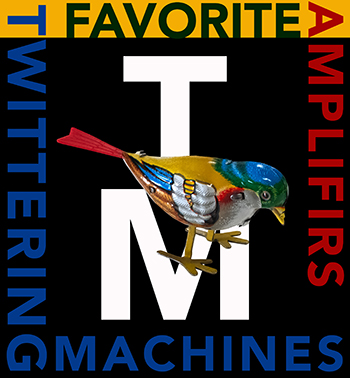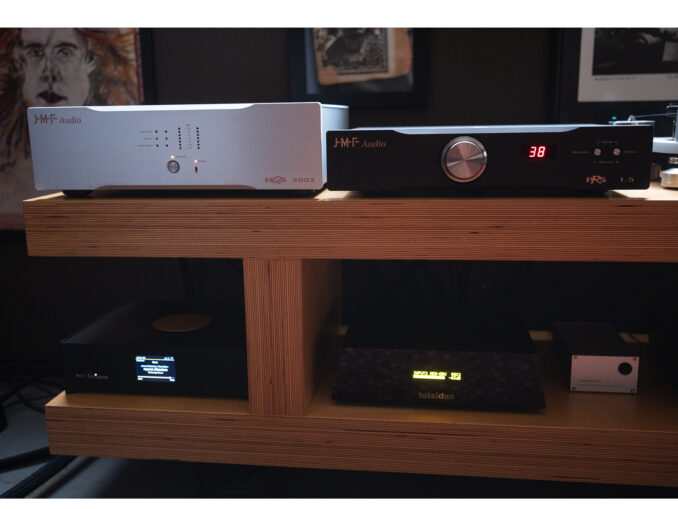
Astonishingly right. After struggling with how best to describe the JMF Audio PRS 1.5 Pre/HQS 6002 pre/power combo, these 2 words seemed to size things up best.
The JMF Audio pre/power combo ranks among the most engaging and astonishingly right sounding amplification I’ve had the great pleasure to live with and I would rank the pair as being among the best to have come through the Barn at the all important task of reproducing music. Even familiar music, albums and songs I know all too well took on new life, as if aspects of the performance had been laying in wait all these years, waiting for the JMF combo to bring them to fuller life. And I share these thoughts as seriously and soberly as one possibly can when confronted by some of the deepest connections to music I’ve had in my life.
The standout qualities of the JMF Audio pre/power combo are not limited to any specific aspect of reproduction or even some group of strengths. Rather, the JMF gear seems to take hold of the entire performance and recreate it as convincingly and completely as any I’ve heard. The whole note, the complete breath, the entire picture drawn out in air in space with as much force and life and detail and color as I’ve had the great pleasure to experience over the course of their 2-month+ Barn stay.

The YG Sonja 3.3 were the first pair of speakers to get the JMF treatment and I immediately recognized the magic. From the Sonja 3.3 review:
While these very fine integrated amps drove the Sonja 3.3 with power to spare, the JMF Audio stack raised the overall performance bar by a significant factor. Significant. This kind of difference is not just the ability to play louder due to more watts, rather it’s a combination of effortless control from bottom to top coupled with music reproduction that sounds and feels perfectly natural regardless of level. Fully formed, fully voiced.
Perfectly natural is another nice way to put it. When reproduction reaches this level of wonder with its ability to recreate a believably real performance, any barriers between listener and performer evaporate into thin air like some great magic trick that leaves one wondering—where the hell did that elephant go?

Jean-Marie Fusilier founded his company in 1974 near the Alsace region in France specializing in “high frequency and infra-red remote control systems for industrial, defense and nuclear plants applications.” The audio division was created in 1985 where JMF Audio “developed linear audio solid state power amplifiers with an unprecedented approach: high voltage rails for greater headroom, high current enabled outputs for the best control of the speakers, selected and matched transistors for linearity, selection of high purity materials to carry the signal, short signal path circuit design, direct coupling, high internal energy reserve for best transient response, made to measure passive components by specialists in aerospace and defense, use of techniques and components normally intended for telecom and radar systems… to serve the music.”
Early clients were from pro audio where JMF Audio gear found homes in recording studios around the world. Jean-Marie Fusilier’s sons Laurent and Arnaud, both with engineering degrees, joined JMF in the early 2000’s. You can read more about JMF’s history on their website.
Here’s a more general quote on JMF’s philosophy:
JMF Audio believes that only precision can guarantee the desired musicality and expression for all genres of music. In addition to innovation, advanced engineering and excellent measurement results, our process involves a subtle convergence of scientific rigor, evaluations by listening and craftsman’s work of art to reach the pinnacle in musical rendering: a three dimensional sound stage, beauty of timbres, subtle ambiances, the fullness, the emotion.
Only a few parameters are measurable with traditional methods and this is where knowhow makes the difference. JMF Audio’s products and components are designed in-house and assembled by our experienced technicians. Every unit undergoes a hundred-hour minimum burn-in period before tests and calibrations. Every unit is verified by listening in our studios before shipment, to ensure that every customer receives the best.
I include this longish quote because it’s useful information and according to my experience, JMF have achieved their stated goals.

The JMF PRS 1.5 preamplifier is a true dual-mono design and employs the company’s proprietary CSV passive volume control that “features zero noise, zero distortion, zero phase shift, infinite headroom” while offering 70 steps of 1dB from either the silky smooth volume control machined from a block of steel or the included chunky aluminum remote. Filling in the rest of the front panel we find an LED display for volume level and input selection when a change is made and a small red light to indicate mute status along with 2 push buttons that control Standby mode, Direct Out for use with an external device such as a headphone amp, Mute, and Source Control. These buttons also provide access to the PRS 1.5 ’s Volume Offset allowing for a range of -9dB to +6dB levels for each input/source.

From JMF:
The PRS 1.5 takes advantage of JMF Audio’s innovative and still unrivaled hand calibrated precision balanced input stage, enabling 100dB of typical interference rejection. This means 30 to 100 times better than professional balanced circuitry. This parameter has been enhanced based on psychoacoustic criteria.
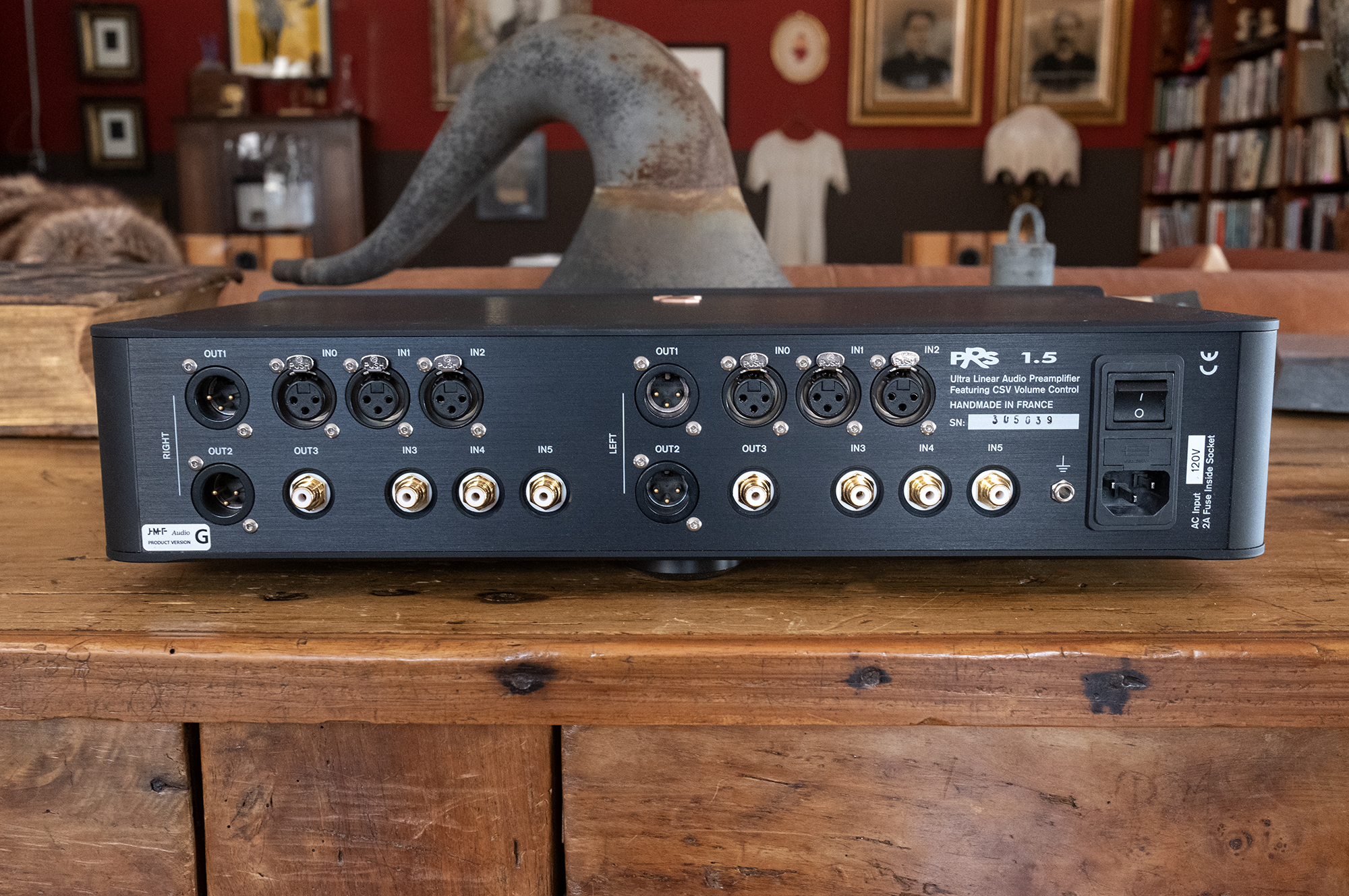
A total of 6 inputs (3x RCA, 3x XLR) join 3 outputs (1x RCA, 2xXLR) which are grouped by channel on the unit’s rear panel. The unbalanced inputs are “automatically balanced at the input and take advantage of the symmetrical amplification structure.” A power switch, chassis ground terminal, and IEC inlet complete this picture.
The PRS 1.5’s sealed chassis is machined from a block of aluminum into 10mm thick panels and inside “the mono audio circuit boards are mounted on a semi-floating sub-chassis for superior immunity to vibrations.” The PRS 1.5 sits on proprietary JMF decoupling, anti-skid feet.
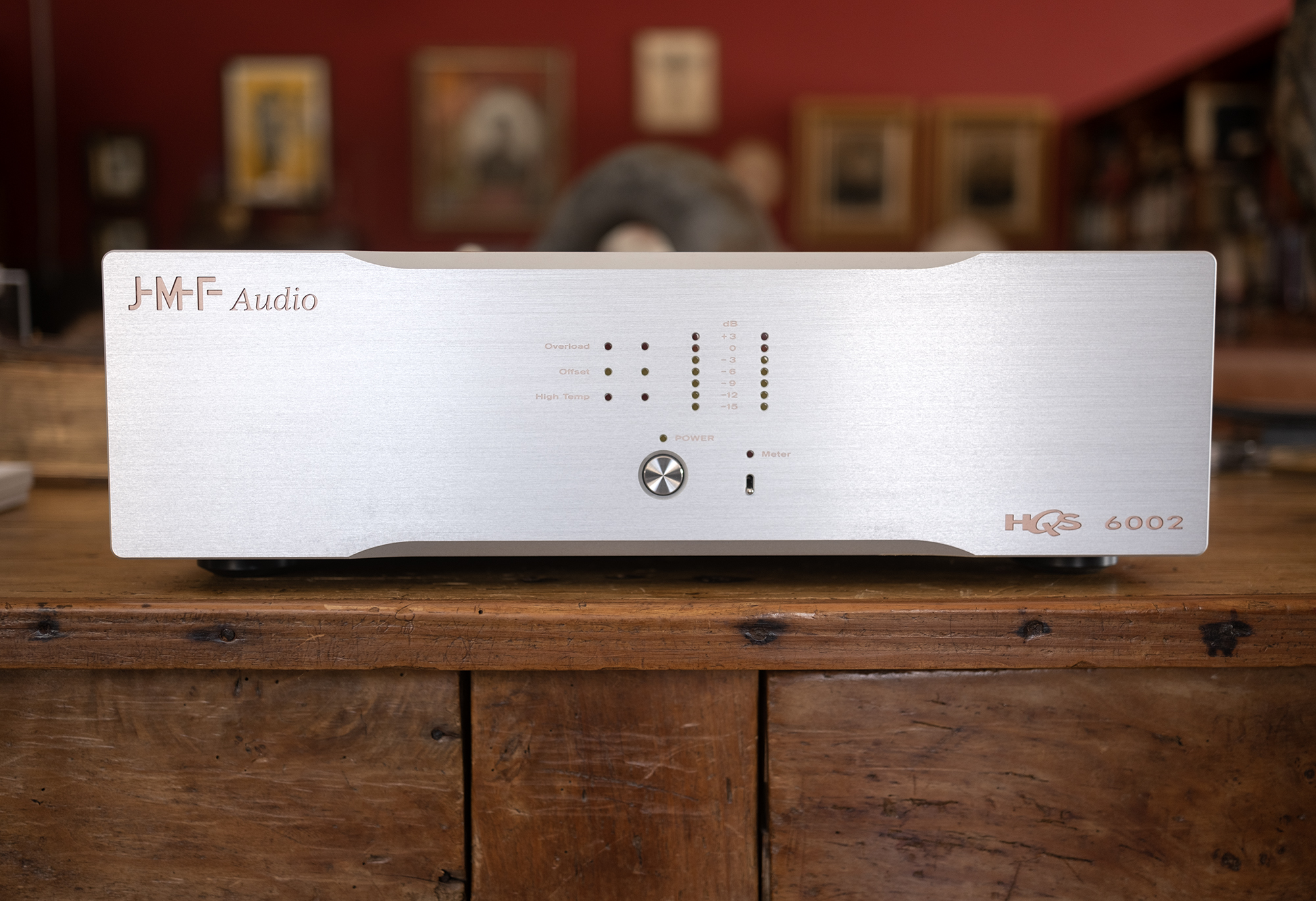
JMF makes three power amplifiers—the stereo HQS 6002, the HQS 7001 monoblocks, and the reference HQS 9001 monoblocks. There’s no integrated amp in the JMF line (sigh, but I understand why). The HQS 6002 operates in Class A/B and puts out 220W into 8 Ohms, 400W into 4, and 550W into a 2 Ohm load. JMF recommends a minimum 2 Ohm load impedance for HQS 6002 so if your speakers present a gnarlier load, move up the line to the monos. The company rates the HQS 6002’s bandwidth at “better than 0.1dB 3Hz..20kHz for 250W / 4Ω, small signals better than -1dB at 100kHz”.
From JMF:
The approach behind the JMF Audio HQS power amplifiers can be summarized as follows:
- High reserve of energy for instant delivery at the output on fortissimo. Achieved with the proprietary RPS concept involving toroidal transformers and capacitors made in France to JMF Audio’s strict specifications.
- High voltage electronics for superior headroom and higher efficiency. A linear amplification by design, a short signal path starting with a hand-calibrated precision balanced input stage. These are key features of the LDA driver board, the center piece.
- High current output capability for best possible control, allowing the amplification structure not to rely on compensations, yet featuring a high damping factor by nature. The base of the proprietary MTP concept.
I especially appreciated this part:
The JMF Audio founder desired a lively yet controlled rendering for all types of musics… Even with high sensitivity loudspeakers, this meant significant driving force, precision and very low noise floor.
And I liked that part because I heard it play out through the 96 dB/W/M DeVore O/96.
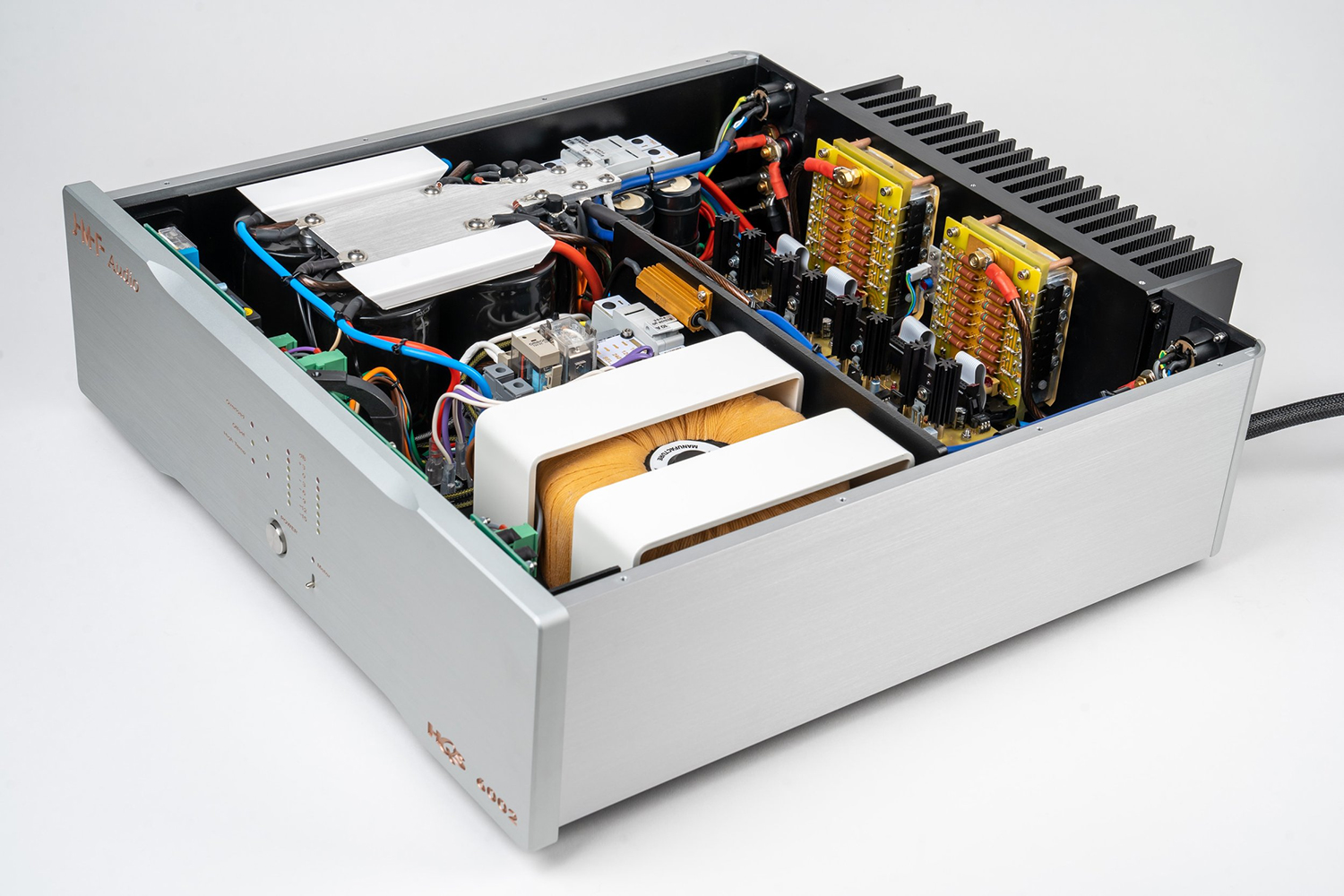
I recommend a trip to the JMF website, this time to the Power Amplifiers page, where you’ll get a more in-depth story including more interior photos that show off the quality of everything from parts to execution to build quality. All JMF gear is handmade in-house down to the 700 or so parts on the 24 carat gold analog printed circuit boards.
The HQS 6002’s front panel includes a centered power button flanked by 3 status LEDs to its left showing Protection Status (Overload, Offset, and High Temp), a VU Meter using two vertical rows of LEDs one per channel, and a Meter toggle switch to engage/disengage the VU Meter (JMF recommends turning it off for listening).

There’s one balanced XLR input per channel on the HQA 6002 with speaker binding posts both on either side reflecting its dual-mono design. In addition to the gold plated posts for spades and bananas, the amplifiers feature JMF Audio LSS ‘no loss’ terminals as well as a JMF Audio designed captive power cord.

The cases for the preamp and amp come in silver or black as you can see and I appreciate the understated appearance of the JMF gear with the matching chamfered front panels. Overall build quality is superb as it should be for gear in this price class and the JMF stack exudes a kind of quiet confidence, even more so when you have to pick ‘em up. And the volume control on the PRE 1.5 has a lovely glide-to-resistance ratio feeling like the tumbler mechanism on an antique Swiss safe.
It seems to me there a number of schools in hifi and at least one of them gets scared off with talk of things like accuracy, measurements, and solid state. The reason being, these things sometimes translate into gear that can sound sterile, lacking in emotion. A kind of sonic autopsy as I like to describe it. The thing of it is, this generalization misses the mark in the same way people who believe electronics that use vacuum tubes are simply ‘distortion machines’. As is the case with politics and art, there’s less reason and more emotion to be found at the extremes and the same goes for hifi. The good news is we can have reason and emotion in balance if we’re ready to let go of silly and extreme oversimplifications. When we’re ready to listen.
Bristol-based 4-piece Quade’s The Foel Tower is among the tastiest albums of late, released on AD 93 back in April.
From the liner notes:
For their second album ‘The Foel Tower’, Quade holed up in an old stone barn in the cradle of a Welsh mountain valley.
The valley was a stark and windswept backdrop with little daylight, as the band would huddle around crackling fires each evening. “There was very much a feeling of being on the complete fringes of society,” the band says. “The last vestiges of settlement before the unrelenting barren moors that loomed over us.”
You can hear, at least I imagine I can, the importance of silence running through these songs that go from gentle to menacing, from delicate to destructive, one moment to the next. Instruments including violin, piano, acoustic and electric guitar, bass, ‘hardware’, and drums are laid out in a vast space with real emphasis on sound, tone, and texture and the JMF pre/power combo brought out each element as well as the resounding whole with more delicacy, voice, and force than I’ve heard before. Each element of sound from dynamics to tone and texture, from the lowest bass to the highest violin squeals to the machine gun rap of Leo Fini’s percussion are fully formed with a dimensional quality in air that digs as deeply into the sounds of things as I’ve heard. The only other electronics I’ve reviewed that offer a similarly three dimensional portrayal are from Riviera Labs.
What this level of reproduction translates into is a completely believable music experience in and of itself, where you can hear as far into the recording, into the choices made in the recording studio, as you care to go while never loosing sight of the bigger musical picture. I find this level of reproduction both addictive and stunning, stunning because you feel perfectly connected to the music as it unfolds in time.
Olivier Messiaen’s Quatuor de la fin du Temps (“Quartet of the End of Time”) was written in a German prison camp during WWII by Messiaen for clarinet (in B-flat), violin, cello, and piano, instruments played by fellow prisoners of war. I was reminded of this masterful work by news of the new Deutsche Grammophon LP from their “audiophile vinyl series” mixed and edited from the original 8-track tapes. My copy is on order.
Messian wrote:
“Music which lulls to sleep and which sings, which is of new blood, speaking gestures, an unknown fragrance, an unsleeping bird; music of stained-glass church windows, a whirl of complementary colours, a theological rainbow.”
I have a ripped CD version of this performance on Deutsche Grammophon by Albert Tétard, Daniel Barenboim, Claude Desurmont, and Luben Yordanoff and it is music I listen to sparingly to save and savor its beauty. This is also a perfect pick to further highlight those things the JMF gear does so well, chief among its standout qualities being the ability to give not only voice but dimensional body to each instrument as you very nearly feel the volume of air inside Desurmont’s clarinet describing its form and function. Individual voices are as well defined and fleshed out as I’ve heard with piano ringing out true all to the point of being led to the mastery of these musicians and well into the sorrow, hope, and resilience of the story they tell. Stunningly, ravishingly so.
Smerz’s latest Big city life is all jangles, bangles, and bows, metaphorically speaking, a jaunty romp from dance hall to trip-hop with stops in between. Big city life is also wonderfully skeletal in construction while taking its time to unfold the groove. Norway’s Smerz is Catharina Stoltenberg and Henriette Motzfeldt and they know a groove when they make one replete with big bass, big percussive slaps, whirring electronics, and smoldering spoken-sung vocals. Here, the JMF gear showed off its superb dynamic-abilities with startling snap and precision, stopping and starting on something smaller than a dime along with its ability to make among the bestest, biggest, and most well-formed bass I’ve heard from the DeVores.
Even here, you get the clear picture of every element no matter the density which speaks to resolution and what seems like a complete absence of self-noise. Think clean, rich, and raucous (the music and the reproduction). I will also highlight the JMF gear’s ability to make the speakers disappear completely, replacing them with a sound image as dimensionally accurate, refined, and as huge as I’ve heard. When reproduction hits so hard, when called for, while doing delicate equally convincingly, listening hones in on what’s going in the music as deeply as you care to go. For me, this translated into lots of smiles, head-shaking wonder, singing out loud (something no one wants to hear), and dancing (something no one wants to see). Basically listening becomes a celebration of music and all the things it has to tell us about living.
I listened to days and weeks of music through the JMF stack, album after album’s worth, just for the fun of it. I also went through more ‘test tracks’ than usual as I simply wanted to hear them anew.
A favorite album is Bob Dylan’s World Gone Wrong from 1993, a collection of folk songs as performed by Dylan with his harmonica and acoustic guitar, recorded in his Malibu home garage studio. One thing about this record, from a sound quality perspective, is something went wrong with the first track “World Gone Wrong” as it sounds like Bob is singing into an old oil can. It’s nearly off-putting enough to put you off this otherwise great record and the JMF stack made this issue, muffled cupped-sounding vocals, more apparent than I’ve heard before and you might think, that’s bad, but it actually made this compromised track more listenable because it was easier to hear and understand the problem. When it comes to reproduction, the funny thing is revealing done right is as listenable as less resolving gear that blurs things enough to make even bad sound pleasant.
This is simple music where the focus is on Dylan, obviously, his mastery of song and the stories they tell and the JMF gear driving the DeVore O/96 brought me intimately close to all of it. Guitar picked and strummed was strikingly present, harmonica sounded like harmonica instead of an aural torture device, and Dylan’s voice sounded as if it was made to tell these tales all up close and personal.

The thing of it is, I love listening to music. I do it every day for most of the day and for much of the time it’s the only thing I’m doing—just sitting and listening—and I’ve been doing this, professionally, for 14 years. The last 11 in the Barn where I’ve had the good fortune to listen to and write about all kinds of gear from source to amplification to speakers. And in all that time, a few products have stood out, stood apart from the others because they dig deeper and reveal more of the music than everything else.
These standouts include a number of DACs from totaldac including the Barn resident d1-unity (review), the Grimm MU2 (review), Riviera Labs Levante integrated (review) as well as their APL10/AFM25 pre/power combo (review), the Soulution 331 integrated amp (review), the Barn resident DeVore O/96 speakers (review), and the Rockport Atria II (review). To name a few and the JMF Audio PRS 1.5 Pre/HQS 6002 pre/power combo not only join this short list of standouts but they sit at the top.

In terms of comparisons, it’s been too long since the Riviera and Soulution gear left for me to make any meaningful comments here and the price differences coupled with comparing integrated amps to separates would render anything I have to say less than useful. A more useful A/B/C would have been to compare the Riviera and Soulution separates of similar cost but that was simply not possible.
I will share that my memory of the Riviera and Soulution gear, with a reread and refresh of those reviews, suggests that they impart a bit more of their own character on reproduction where the Riviera gear makes music nearly glow with dimensional beauty while the Soulution 331 lit music up from the inside with great clarity and refinement. The JMF stack feels more transparent but it’s a kind of see through to the performer performing transparency as opposed to some mechanical machine language that pleases a test bench more than a human.
To put it another way, I think I’ll miss the JMF gear’s way with music the most.

In terms of speaker pairings used here, if I owned the YG Sonja 3.3 I’d opt for the JMF HQS 7001 or the HQA 9001 monoblocks because the big YGs will enjoy the extra drive and as odd a pairing as it may seem, price-wise, it was the DeVore O/96 that told me more about the JMF gear’s outstanding performance. I’ll chalk this up to my familiarity with the O/96 and the fact that I’ve used dozens of amplification partners with ‘em of all kinds and prices. One thing I’ll say about the O/96 is they’ve risen to every occasion with every amplification partner including the JMF combo and I love a speaker that has the ability to get better and better and….

Two months is a lot of time. Then again, it’s not all that much time as I could have lived with the JMF stack longer, paired it with more speakers, and more than likely learned more about what they’re capable of. Nonetheless, there’s no doubt that the PRS 1.5 Preamplifier and HQS 6002 Amplifier are among the best I’ve heard and they are clearly the most musically fulfilling amplification devices I’ve had the pleasure of living with.
When all is said and done, listening to music is not a difficult thing to do. It’s easy. And it was easy to hear and experience the exceptional qualities of the JMF Audio PRS 1.5 Preamplifier and HQS 6002 Amplifier because they made music sound and feel astonishingly right in every way. That being the case they come with my highest heartfelt recommendation.
JMF Audio PRS 1.5 Preamplifier
Price: $39,000
JMF AudioHQS 6002 Amplifier
Price: $45,000
Company Website: JMF Audio
US Distributor Website: Audio Skies
JMF Audio PRS 1.5 Preamplifier Specifications
Features:
Balanced inputs: 3 (IN0, IN1, IN2)
Unbalanced inputs: 3 (IN3, IN4, IN5)
Balanced outputs: 2 (OUT1, OUT2) allowing bi-amplification
Unbalanced outputs: 1 (OUT3) modular, fixed or variable
Volume display: [30] to [99]
Relative volume setting between sources: [-9] to [ 6] display for -9 to +6dB
Source display: [i0] to [i5]
OUT3 set as variable output (default): For active sub-woofers or a headphone amplifier
OUT3 set as fixed line level output (direct): For a tape loop (reel-to-reel or recorder) or a headphone amplifier, upon pressing Direct button. [di] displayed on selection, recalled by a dot light during normal use
Bypass for surround sound AV processor: from IN5 (unbalanced) upon configuration or IN2 (balanced) in option
Ground connection (earth): dia. 4mm type
Remote control: JMF Audio MBR1, user selectable code-set to prevent from interference
Technical Specifications
Input impedance: Maximum input level at up to unity gain
Maximum input level at max volume: 9V (+20dBu, XLR bal) / 4V (+14dBu, RCA)
Maximum input level at max volume: 3V (+11dBu, XLR bal) / 1.4V (+5dBu, RCA), version F
Maximum output level: 10V (+22dBu) into 10k ohms load
Global signal bandwidth:
1Hz..150kHz (intentionally limited for RF immunity)
20Hz ..20kHz (+0.0 / –0.0dB)
Signal to noise ratio (SNR): 120dBA typ. (+22dBu), version F
Total harmonic distortion plus noise: 0.0002% typ. (+22dBu 1kHz in / bw. 22..22k Hz)
Channel Separation: >100dB (10V output 1kHz, gain min)
Interferences: rejection (balanced input): 100dB typ.
Output impedance: 50 ohms
Maximum gain output/input:
12dB (XLR bal in) +18dB (RCA in), version F
0dB (XLR bal in) +6dB (RCA in), prior to version F
Volume control range: 70 steps of 1dB
Volume control step precision: better than 0.05dB above volume [40]
Volume control left/right level mismatch: < 0.1dB above volume [40]
Specific to modular output OUT3:
Maximum gain in variable mode: 12dB (RCA in / RCA out), version F
Output impedance in variable mode: 50 ohms
Gain in direct mode: 0dB (RCA in/RCA out) -6dB (XLR in/RCA out)
Output impedance in direct mode: 600 ohms
AC mains power supply: 100, 120, 220-240 V AC – 50/60Hz (according to country of destination), version G
Power consumption: < 30W in operation (< 2W in standby), version G
Enclosure: Orose® up to 16mm thick machined anodized aluminum, machined steel buttons and rose-gold
Dimensions: 482 wide (front panel) x 320 deep x 106 high mm including feet (19” x 12.6” x 4.2” high)
Net weight: 14 kg (31 lbs), version G
Finishes: Silver or Black anodizing
Measurements with Audio Precision APX555 equipment. Voltage values are RMS. Specifications are based on the manufactured products at date of writing and may change with product evolution.
JMF AudioHQS 6002 Amplifier Specifications
Input
Impedance: 20kΩ
Output current capability: 80A per channel
Connection: XLR – metal case, gold contacts
Interference rejection: 100dB typ., based on psychoacoustic criteria
Type: Hand calibrated precision balanced input stage (impedance matched to PRS 1.5)
Monitoring: Level metering (-15dB to +3dB, deactivatable), Input offset, Overload, High temperature
Gain: 34.6 dB (all models have the same voltage gain which eases multi-amplification)
Output:
Output power RMS: 200W / 8Ω 400W / 4Ω 550W / 2Ω for one channel
Output current capability: 80A per channel
Load impedance: > 2Ω recommended (tested down to 1Ω at full output power at the manufacture)
Connection: JMF Audio LSS dia. 6mm (120A continuous rated) and gold plated WBT for forks or wires
Bandwidth: Better than 0.1dB 3Hz..20kHz for 250W / 4Ω, small signals better than -1dB at 100kHz
THD+N: Better than 0.01% for 250W / 4Ω at 1kHz (0.001% typ. un-loaded) BW. 20Hz-20kHz
Signal to noise ratio: 110dB typ. un-weighted BW. 20Hz-20kHz
Damping Factor: Better than 1000 at 8Ω, wide-band, for one channel
Audio signal coupling: Direct coupling
Protection Circuits:
Automatic protection against high frequency large signals
Automatic protection against input offset voltage and subsonic (fc 3Hz)
Automatic protection against overheating
Automatic protection against overload and short circuits
Mains voltage supervision (protections activation reported on front panel)
AC Mains Power Supply: 100, 120, 220-240 V AC – 50/60Hz (according to country of destination)
Cooling: Passive cooling | Sealed case design (no air path inside amplifier, preventing from dust)
Enclosure: Orose® up to 16mm thick anodized aluminum external enclosure including steel controls and rose-gold
Dimensions (Version G): 482 wide (front panel) x 539 deep x 149 high mm including feet (19” wide x 21.5” deep x 5.9” high)
Net Weight (Version G): 34 kg /pc (75 lbs /pc)
Finishes: Silver or Black anodizing
Voltage values are RMS. Measures on 230V AC power supply after 100 hours of operation. Specifications are based on the manufactured products at date of writing and may change with product evolution. Measurements with Audio Precision APX 555 equipment.

